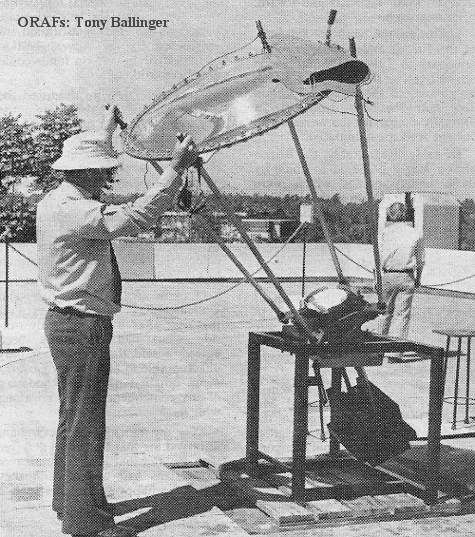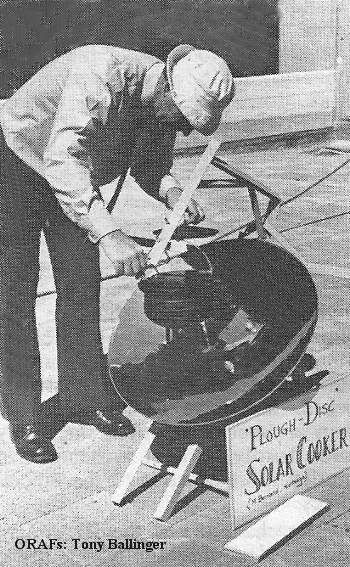Tapping the Sun's Eternal Energy
By Lachlan McCrudden

This solar power lens achieves temperatures up to 1 700 degrees
celsius.
Organic materials, which through natural evolution have been converted into coal, oil and natural gas, today provide 99 per cent, of the world's energy. The inevitable and rapid exhaustion of these fossil fuels and the resultant increase in price has spurred the search for a new energy source and that source could be the sun.
The Rhodesian climate is almost perfect for exploiting solar energy and Focus spoke to John West, the Prime Minister's energy adviser, about how Rhodesians are using the sun's power.
"Although the use of solar power is in its infancy, especially in a country like Rhodesia, which has very cheap electricity, more than 100 solar heating systems are in use throughout the country," said Mr. West. "We use the sun's heat for two main purposes—water heating and crop drying.
LOW COST
"We are in any case looking to the future. Power costs here are too low at the moment for any large scale application of solar power. But because conditions here are so suitable for using this energy, we are starting in a small way to develop for the future.
"The other major application of solar energy in Rhodesia is for crop drying. One farmer near Salisbury has been using the sun's heat to dry his crops for the past 10 years," said Mr. West. "The drying unit is an ordinary farm barn running from east to west. This is important, as a north/south barn would not collect nearly as much heat.
"The barn has two sloping roofs, each with two layers of corrugated iron with a 155 mm gap between them. The top layer is painted black for maximum heat retention and the warm air which is trapped between the two layers is sucked out by fans. It is pushed through a screen which forms the floor of the crop-drying bin. The warm air rushes up through the screen and dries the crop.
"The unit is used for drying onions, lucerne and maize," he said. "With maize, the farmer can reduce his moisture content from 20 per cent, to 13 per cent, in four days. It is also ideal for drying onions, which take a long time to cure. The only cost to the farmer is the electricity used by the fans. And funnily enough, its effectiveness lies in its inefficiency — the crops are dried slowly and gently and there is no danger of over-drying or scorching."

A solar cooker experiment
Tobacco requires high temperatures for curing and at least 20 farmers have effected a considerable saving by using a similar system to preheat their curing air. They draw the air from a heating space under the roof and feed it directly into their heating tunnels.
By this method, said Mr. West, the air from one roof could be heated to 60° Celsius on a clear, sunny day.
The resultant saving in fuel costs was about 15 per cent. Speaking about the generation of power through electric solar cells, Mr. West said the process was both expensive and difficult.
"Electric solar cells, which are basically made up of silicon, doped in a special way, have a very low efficiency and are expensive for ordinary use," he said. "They were developed for use in the American space programme and in space, where there is no energy source but the sun, they proved their worth. But on earth they are not really practical for ordinary use.
"In certain cases, however, we have used them for charging batteries in deserted spots where difficulty of access has made them more economical. Water level monitoring stations on the Zambezi River, for example, where access is expensive and difficult, are powered by these cells."
In Rhodesia at present, and in fact in most of the world, solar heating is not economic compared with the energy derived from conventional fuels. John West believes that this will change as these fuels become ever more scarce and expensive.

This reflector collects heat into a central point, reaching temperatures up to
600 degrees celsius.
"In Rhodesia's case this will mean that heating systems have a far larger local content than at present. The generation of power in hydro and thermal stations requires the use of imported machinery and, of course, we like to save any foreign currency we can," he said.
Asked what were the limitations in solar energy, Mr. West said that, apart from the fairly high cost of storing the heat generated by the sun, seasonal and daily fluctuations of temperature would always be a problem.
CLOUD
"Rhodesia is less susceptible to seasonal variations than most places, because we have such sunny winters. But just ask people who heat their bath water what effect several cloudy days have on their hot water and you will see how this can be a problem. And, of course, rain is a complete disaster!"
Solar energy did, however, have a practical application in Rhodesia and as Rhodesian electrical costs rose, it would become more attractive.
"The British government spends millions of pounds investigating solar power and it expects to use solar energy equivalent to 20 000 000 tonnes of coal by the year 2000," he said. "And if they can do that with their climate, imagine the potential here!"
End
Extracted by Eddy Norris from the publication Focus on Rhodesia, Vol. 2, No. 8.
Material made available to ORAFs by Tony Ballinger (RhArmy). Thanks Tony.
Comments are always welcome - please send them to Eddy Norris at orafs11@gmail.com
Thanks to:-
My son, Paul Norris, for the ISP sponsorship.
Paul Mroz for the image hosting sponsorship.
Robb Ellis for his assistance.

This solar power lens achieves temperatures up to 1 700 degrees
celsius.
Organic materials, which through natural evolution have been converted into coal, oil and natural gas, today provide 99 per cent, of the world's energy. The inevitable and rapid exhaustion of these fossil fuels and the resultant increase in price has spurred the search for a new energy source and that source could be the sun.
Solar energy has significant advantages over more conventional sources of energy. A major advantage is that it is pollution free and in today's world that is important. All countries receive it and it therefore has no strategic or political implications. It is available on site, so transport is not needed. And above all, it provides eternal energy.
The Rhodesian climate is almost perfect for exploiting solar energy and Focus spoke to John West, the Prime Minister's energy adviser, about how Rhodesians are using the sun's power.
"Although the use of solar power is in its infancy, especially in a country like Rhodesia, which has very cheap electricity, more than 100 solar heating systems are in use throughout the country," said Mr. West. "We use the sun's heat for two main purposes—water heating and crop drying.
"We have taken the lead by installing large sets of solar heaters on communal buildings, such as school hostels and army barracks. At Marlborough School, in Salisbury, for example, the pupils' hot water supply is heated entirely by solar energy," he said.
"The water is pumped through a succession of glass-covered metal trays on the hostel roof. The envelope-shaped trays are painted a matt black and absorb every possible unit of energy from the sun. By the time the water has passed through the last heating box, it has reached a temperature of over 60° Celsius. It is then stored in a large tank and is so hot that cold water has to be added before being used for bathing."
There was also a small number of solar heating units in private use, said Mr. West. "I have one myself, and the water gets hot enough to scald you if you are not careful." His particular heater worked most efficiently in winter, when the sun's rays struck the heating panel at an optimum angle.
The problem with this system of heating water, particularly on a small scale, was that a booster system was needed to keep the water hot during long, cold nights and during rainy weather. Storing the energy, he said, added significantly to the cost of a solar installation.
LOW COST
"We are in any case looking to the future. Power costs here are too low at the moment for any large scale application of solar power. But because conditions here are so suitable for using this energy, we are starting in a small way to develop for the future.
"The other major application of solar energy in Rhodesia is for crop drying. One farmer near Salisbury has been using the sun's heat to dry his crops for the past 10 years," said Mr. West. "The drying unit is an ordinary farm barn running from east to west. This is important, as a north/south barn would not collect nearly as much heat.
"The barn has two sloping roofs, each with two layers of corrugated iron with a 155 mm gap between them. The top layer is painted black for maximum heat retention and the warm air which is trapped between the two layers is sucked out by fans. It is pushed through a screen which forms the floor of the crop-drying bin. The warm air rushes up through the screen and dries the crop.
"The unit is used for drying onions, lucerne and maize," he said. "With maize, the farmer can reduce his moisture content from 20 per cent, to 13 per cent, in four days. It is also ideal for drying onions, which take a long time to cure. The only cost to the farmer is the electricity used by the fans. And funnily enough, its effectiveness lies in its inefficiency — the crops are dried slowly and gently and there is no danger of over-drying or scorching."

A solar cooker experiment
Tobacco requires high temperatures for curing and at least 20 farmers have effected a considerable saving by using a similar system to preheat their curing air. They draw the air from a heating space under the roof and feed it directly into their heating tunnels.
By this method, said Mr. West, the air from one roof could be heated to 60° Celsius on a clear, sunny day.
The resultant saving in fuel costs was about 15 per cent. Speaking about the generation of power through electric solar cells, Mr. West said the process was both expensive and difficult.
"Electric solar cells, which are basically made up of silicon, doped in a special way, have a very low efficiency and are expensive for ordinary use," he said. "They were developed for use in the American space programme and in space, where there is no energy source but the sun, they proved their worth. But on earth they are not really practical for ordinary use.
"In certain cases, however, we have used them for charging batteries in deserted spots where difficulty of access has made them more economical. Water level monitoring stations on the Zambezi River, for example, where access is expensive and difficult, are powered by these cells."
In Rhodesia at present, and in fact in most of the world, solar heating is not economic compared with the energy derived from conventional fuels. John West believes that this will change as these fuels become ever more scarce and expensive.

This reflector collects heat into a central point, reaching temperatures up to
600 degrees celsius.
"In Rhodesia's case this will mean that heating systems have a far larger local content than at present. The generation of power in hydro and thermal stations requires the use of imported machinery and, of course, we like to save any foreign currency we can," he said.
Asked what were the limitations in solar energy, Mr. West said that, apart from the fairly high cost of storing the heat generated by the sun, seasonal and daily fluctuations of temperature would always be a problem.
CLOUD
"Rhodesia is less susceptible to seasonal variations than most places, because we have such sunny winters. But just ask people who heat their bath water what effect several cloudy days have on their hot water and you will see how this can be a problem. And, of course, rain is a complete disaster!"
Solar energy did, however, have a practical application in Rhodesia and as Rhodesian electrical costs rose, it would become more attractive.
"The British government spends millions of pounds investigating solar power and it expects to use solar energy equivalent to 20 000 000 tonnes of coal by the year 2000," he said. "And if they can do that with their climate, imagine the potential here!"
End
Extracted by Eddy Norris from the publication Focus on Rhodesia, Vol. 2, No. 8.
Material made available to ORAFs by Tony Ballinger (RhArmy). Thanks Tony.
Comments are always welcome - please send them to Eddy Norris at orafs11@gmail.com
Thanks to:-
My son, Paul Norris, for the ISP sponsorship.
Paul Mroz for the image hosting sponsorship.
Robb Ellis for his assistance.
Labels: McCrudden, Sun's eternal energy


0 Comments:
Post a Comment
Subscribe to Post Comments [Atom]
<< Home